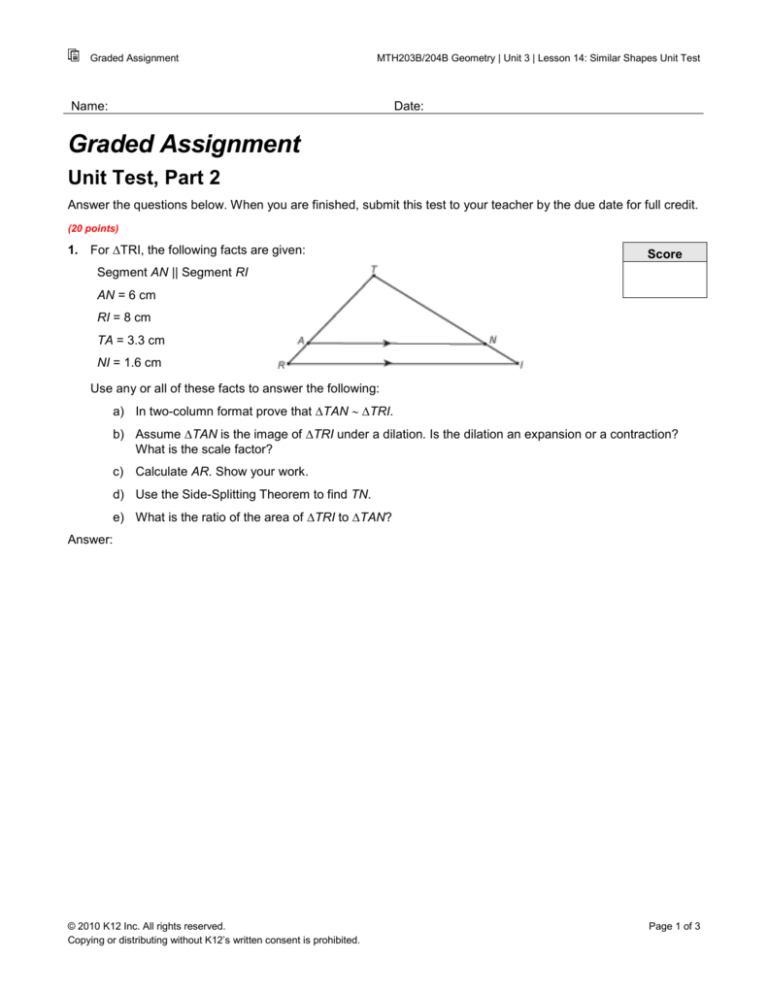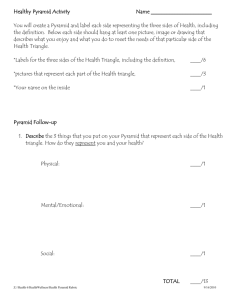
Graded Assignment
MTH203B/204B Geometry | Unit 3 | Lesson 14: Similar Shapes Unit Test
Name:
Date:
Graded Assignment
Unit Test, Part 2
Answer the questions below. When you are finished, submit this test to your teacher by the due date for full credit.
(20 points)
1. For TRI, the following facts are given:
Score
Segment AN || Segment RI
AN = 6 cm
RI = 8 cm
TA = 3.3 cm
NI = 1.6 cm
Use any or all of these facts to answer the following:
a) In two-column format prove that TAN TRI.
b) Assume TAN is the image of TRI under a dilation. Is the dilation an expansion or a contraction?
What is the scale factor?
c) Calculate AR. Show your work.
d) Use the Side-Splitting Theorem to find TN.
e) What is the ratio of the area of TRI to TAN?
Answer:
© 2010 K12 Inc. All rights reserved.
Copying or distributing without K12’s written consent is prohibited.
Page 1 of 3
Graded Assignment
MTH203B/204B Geometry | Unit 3 | Lesson 14: Similar Shapes Unit Test
(12 points)
2. The height of one solid limestone square pyramid is 24 m. A similar solid limestone square
pyramid has a height of 30 m. The volume of the larger pyramid is 16,000 m 3. Determine
each of the following, showing all your work and reasoning.
Score
a) The scale factor of the smaller pyramid to the larger pyramid in simplest form.
b) The ratio of the area of the base of the smaller pyramid to the larger pyramid.
c) Ratio of the volume of the smaller pyramid to the larger.
d) The volume of the smaller pyramid.
Answer:
a.) h1 : h2 = 24 : 30 = 24/30 = 4/5
b.) B2 = 3(16,000/30) = 1,600 m 2
B2 / 1600 = 24 / 30
30B2 / 30 = 38,400 / 30
B2 = 1280m2
Ratio = 1,280 : 1,600 = 1,280 / 1,600 = 4/5
c.) V1 = (16,000m3)(4/5) = 12,800m 3
Ratio = 12,800 / 16,000 = 4/5
d.) V1 = (16,000m3)(4/5) = 12,800m3
© 2010 K12 Inc. All rights reserved.
Copying or distributing without K12’s written consent is prohibited.
Page 2 of 3
Graded Assignment
MTH203B/204B Geometry | Unit 3 | Lesson 14: Similar Shapes Unit Test
(17 points)
3. For TOE the following facts are given:
Score
mTOS = mSOE
TE = 6 cm
OT = 2 cm
OE = 5.8 cm
OG = 4.35 cm
AU = 0.45 cm
Use this information to answer the following:
a) Why is OBG OTE?
Now find the following missing lengths. Show all work or reasoning. Round non-integral lengths to the nearest
hundredth.
b) GE
GE = (OE – OG)
GE = (5.8 – 4.35)
GE = 1.45
c) TS
d) OA
e) BT
(OT – OB) / GE = OB / OG
(2 – OB) / 1.45 = OB / 4.35
8.7 / 5.8 = 5.8OB / 5.8
OB = 1.5
OB / OG = BT / GE
1.5 / 4.35 = BT / 1.45
2.175 / 4.35 = 4.35BT / 4.35
BT = 0.5
f)
SE
g) OU
Your Score
© 2010 K12 Inc. All rights reserved.
Copying or distributing without K12’s written consent is prohibited.
___ of 49
Page 3 of 3








